It occurred to me that the Lumia 900 review would be one of the more important critiques of a product that I write this year. For those of you who don't know the backstory here, the new LTE-equipped, AT&T-bound smartphone represents what could be the beginning of a new era for both Microsoft and its partner Nokia in the mobile race — at least in the US. The 900 is a culmination of all of Microsoft's work with Windows Phone 7 (now 7.5), and Nokia's hardware design and execution, packaged in the hopes that the American consumer will suddenly notice that not only does Windows Phone exist, but it's worth buying into.
Even AT&T has gotten into the spirit, claiming launch expectations that seem to far exceed the warranted excitement over this phone. But it is an attractive offering in many ways. Stylistically the Lumia 900 looks like nothing on the market. It offers LTE service that — where you can get it — is shockingly fast. And most importantly, the top-tier, flagship device is being offered at a wildly discounted price: just $99.99 for new subscribers.
So does the phone have what it takes to court buyers away from Android and iOS, and establish a beachhead for Microsoft and Nokia? I'll unravel those questions in the review below.
Video Review
The Lumia 900 is a gorgeous device. It's beautiful. It may be the best looking phone on the market right now. It's a monolithic device — a slab of high-test polycarbonate with little more than a display and a handful of slit-like, silver buttons. Its smooth, matte plastic is shaped to appear rather rectangular from the front, but has subtle curves around the edges which give it a satisfying feel in your hands. The design is nearly identical to the Meego-based N9, and its predecessor Lumia 800, so even though it will be new to many, it's not the first of its kind. Still, in a world dominated by lookalike Android phones and a single iPhone, it's definitely a breath of fresh air.
The Lumia looks and feels like nothing else on the market
Not only is the physical design of the phone different, but so is its coloring. I tested a bright cyan version of the phone (it comes in white and black as well), and I found the stark color extremely pleasing. In fact, it reminded me of how stale and lacking in playfulness industrial design has become in this industry.
The Lumia measures 2.7 inches across by 5.03 inches up and down, and is 0.45 inches thick (comparatively, the iPhone 4S is 0.37 inches in thickness). It's not the smallest or thinnest device on the market, but it never comes off as oversized or chubby. There's a small speaker along the very flat bottom of the phone, and a headphone jack, Micro USB port, and SIM door at the top. Along the right side are the device's volume, power / sleep, and camera buttons.
I really like the design and materials on the 900, and for once I have very little to complain about. I will say that the door which needs to be popped open to insert a SIM does settle back into the top of the phone a little shakily at first, but it does eventually seem to go back to a flush line.
In all, it's a fantastic piece of technology. It just looks and feels like nothing else on the market. It hits all the right notes for me. A little bit retro, a little bit futuristic, with just a touch of quirky humanity in its otherwise very machined design. This is the Nokia I grew up with, and it's clear the company hasn't lost its ability to enchant through hardware.
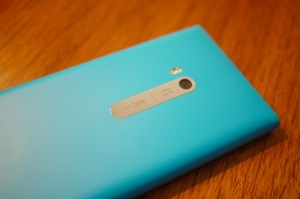
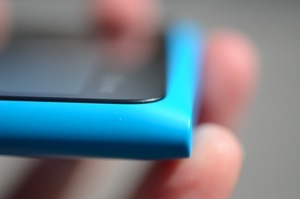
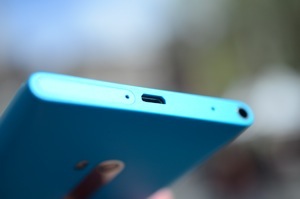
Internals and display
The specs don't exactly make this device future-proof
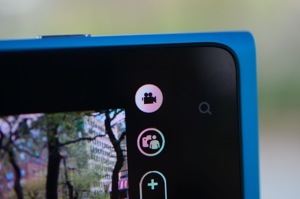
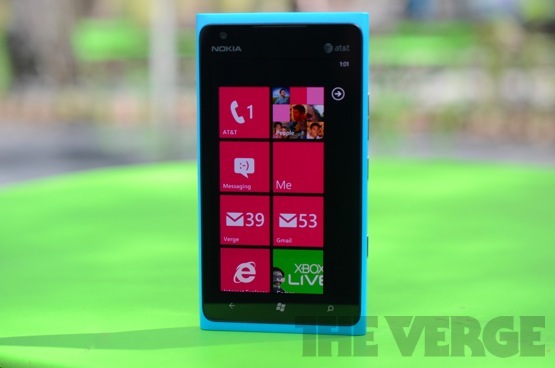
Inside, the Lumia 900 packs a single-core Snapdragon system-on-a-chip clocked to 1.4GHz, 512MB of RAM, and 16GB of internal storage (which is not upgradable). The device has the requisite LTE and GSM radios onboard, Wi-Fi, and Bluetooth 2.1+EDR.
The display on the front of the device is a 4.3-inch, 800 x 480 AMOLED "ClearBlack" screen, fronted by Corning's now-famous Gorilla Glass. Unlike the Lumia 800 and N9, the display is slightly raised on the phone instead of flush with the surface. There's also a 1-megapixel camera embedded above the display, as well as an 8-megapixel shooter with a dual LED flash and Carl Zeiss optics on the back of the phone.
The specs are unremarkable, but performance on the phone was not. Just as with other Windows Phones I've tested, the Lumia was snappy and responsive, with few (if any) hiccups or pauses — but more on that later.
On the other hand, I'm disappointed by the display on the Lumia. Besides being lower in resolution than competitive devices (new Android phones at 1280 x 720 and the iPhone at 960 x 640), I felt colors were far too saturated. This is a pretty common problem with AMOLED screens, but the issue seems pronounced on the Lumia 900 thanks to the starkness of the Windows Phone interface. Combined with the lower resolution display (which is particularly notable with white text against that black background), the effect is jarring.
I'm not saying that the Lumia 900 is underpowered, but a single-core processor, lower resolution display, and half the RAM of its nearest competition doesn't exactly make this device future-proof.

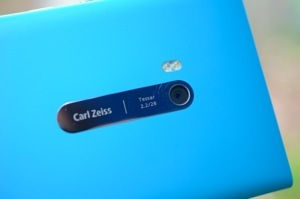
Nokia has a long history of packing terrific optics into its devices, so you would expect that the Lumia would excel in this area. I'm sad to report that it does not.
On the device I tested, the rear camera was capable of producing fine photos, though generally the 900 shot somewhat grainy and very washed out images. It's not that those images were particularly bad — they just weren't particularly good. Though the company touts Carl Zeiss optics, I didn't see anything in my results that belied fairly standard smartphone picture-taking capabilities. In fact, the camera software seemed to have real trouble in some settings, with white balance and exposure out of whack compared to my expectations.
Additionally, the Lumia 900 produces those dreaded, faint pink spots in the center of the display — particularly visible on bright white surfaces — that we've seen on countless phones. It's not the kind of thing you'd notice in most photos, but you can definitely see a discoloration that shouldn't be there.
Now keep in mind, my daily driver is a Galaxy Nexus, which has a relatively poor camera — so this is significant. I went into the Lumia 900 expecting an excellent photo experience, but it's really simply mediocre. That's too bad, because there aren't many phones on the market that can snap great looking photos, and given Microsoft's insistence that Windows Phone is a pro at quickly capturing important moments, this is a place where this phone could have shined.
Battery life, data, phone, and performance
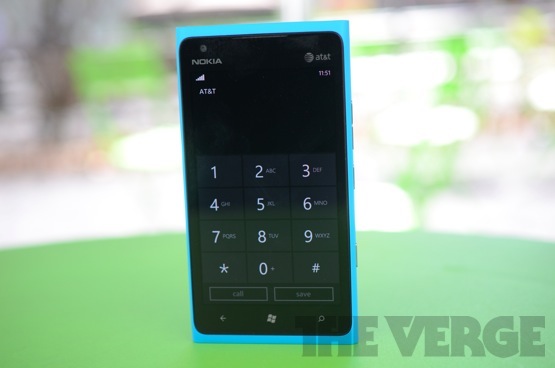
I was very pleasantly surprised by the battery life of the Lumia. Going into an LTE phone review, I tend to have fairly low expectations for battery performance, but the 900 proved itself as a viable option for a full day's work. According to Nokia, you can expect about 7 hours of talk time on the phone. Now, I don't really spend that much time talking, but I was happy to report that getting through a typical day of calls, lots of email, Twitter, and web browsing was no problem — even on a fairly constant LTE connection. Furthermore, in our brute force rundown test (continuous YouTube while connected to both Wi-Fi and LTE, max screen brightness, and max volume) I got 4 hours and 43 minutes. Compared to the HSPA+ One X's 4:22, I'd say that's pretty good.
Data performance was pretty awesome on the Lumia 900 — when I was in range of LTE, of course. I've been over the moon about Verizon's LTE service (see the ridiculous speeds I got while testing the iPad), and AT&T's early showing suggests a match for its rival. In good coverage areas, I saw download speeds as high as 19Mbps, with upstream hovering around 3 or 4Mbps. Of course, those did fluctuate wildly, and AT&T's network still has yet to be built out to full capacity. It probably also doesn't hurt that almost no one is using the company's "real" 4G network.
Phone calls were crisp and clear on the handset. I'm happy to say that during my testing, I didn't have a single dropped call. That could be luck, but I'm hoping it's not. The speakerphone worked well on the Lumia 900, though I thought it sounded a bit sharp for my ears, and not quite as loud as I would have liked. Compared to my annoyingly quiet Galaxy Nexus, however, it might as well have been a PA system.
As far as general performance is concerned, as I said in the hardware section, the Lumia is more than capable of handling anything you throw at it. Of course, what you throw at it is tightly bound by the Windows Phone way of doing things, which all but ensures that there's never too much going on at once. If I had to speculate, I would say it's the stringent methodology of this OS that allows it to seem smooth and stable during the majority of use. Quite simply, Microsoft isn't letting these phones bite off more than they can chew.
That comes with a price, however, and it brings me to...
The Lumia is more than capable of handling anything you throw at it
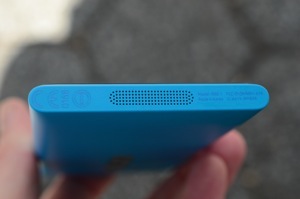
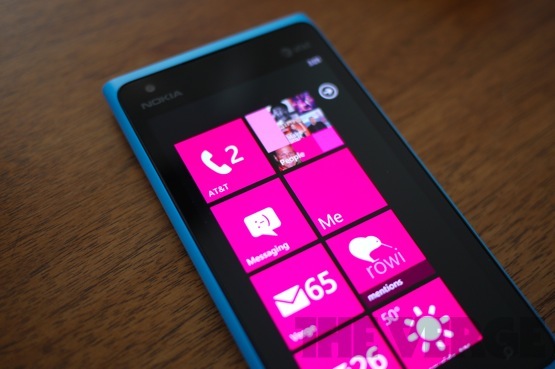
Let me just put this bluntly: I think it's time to stop giving Windows Phone a pass. I think it's time to stop talking about how beautifully designed it is, and what a departure it's been for Microsoft, and how hard the company is working to add features. I am very aware of the hard work and dedication Microsoft has put into this platform, but at the end of the day, Windows Phone is just not as competitive with iOS and Android as it should be right now.
Before you cry foul, keep in mind that I went into this review wanting to fall madly in love with this phone. But like a book with a beautiful jacket and a plot full of holes, I found myself wanting more. A lot more.
The problems with Windows Phone are myriad, many small. But it's a death by a thousand cuts. And all those little problems were once again immediately apparent to me the moment I started using the Lumia 900.
Death by a thousand cuts
The most glaring issues also happen to be some of the oldest issues — things you think at this point would have been dealt with. Scrolling in third party apps, for instance, is still completely erratic. I would blame this on developers, but given that this platform has been around for nearly two years, I think that's a cop out. In new Twitter apps like Carbon, lists of messages will sometimes disappear or skip weirdly when scrolling. I first complained about this in version 1 of Windows Phone, and I thought it had been squashed — it has not.
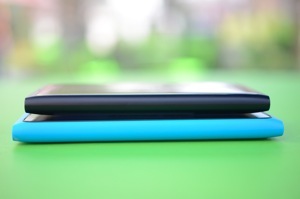


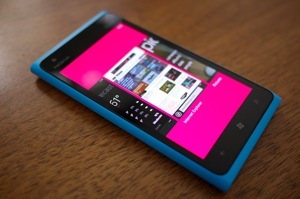
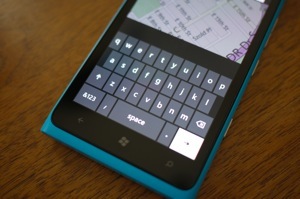
Elsewhere there are missteps. Though Microsoft has added some form of multitasking to the OS, there is nearly never a feeling that apps in the "background" are actually still waiting for you. In fact, many apps still deliver a splash screen to you when you reenter them — if this is a developer issue, then I guess most of the hardworking coders on this platform never got the memo. In short, it kind of sucks to use. Where iOS and Android at least feel responsive in packing and unpacking background apps, Windows Phone often comes across as broken and limp.
Other issues nag me. In the browser, webpages are often displayed incorrectly as IE seems incapable of rendering certain web elements properly. The Verge, for instance, lacks its colored panels in the top stories section, and TypeKit fonts aren't properly displayed. Neither iOS nor the new Chrome browser for Android have this issue. Then there are menus to consider — in many applications, options to navigate are often hidden beneath long presses, meaning that most users will never know how to do simple things like delete a single text message from their inbox.
Microsoft offers Twitter integration, but it's so clunky, it would almost be better to not include it at all. The phone will show you that you've been Tweeted at, but in order to view the actual Tweet you have to tap into your "Me" tile, swipe to your notification list, then tap on each individual message to see it. How anyone at Microsoft thought this would help you get "in, out, and back to life" is a mystery to me.
And all of this is to say nothing of the third party app offerings on the platform. Besides the fact that there is a serious dearth of good software for the OS, even in places where you would expect Windows Phone to excel, it lags. Gaming for instance.
At this point, one would think that the Xbox Live offerings would hold their own against game titles for Android or iOS, but even the most advanced games seem at least a generation behind other platforms in terms of complexity. Furthermore, there's still slim pickings when it comes to titles, with launch offerings from October of 2010 still topping the charts in the Marketplace.
Elsewhere, software is largely a mishmash of fair-to-middling offerings. The design language of Windows Phone seems to present a real problem to developers on the platform, and most third party titles go off the rails badly. Additionally, there's little in the way of familiar apps, though there are bright spots, like the Rdio app which now thankfully is capable of playing audio in the background (which wasn't possible before the recent Mango update), and is actually quite a beautiful piece of software.
There's also a new Twitter app called Rowi which is probably the best experience you can have on Windows Phone with the social networking service — it's a really well thought out and well made application.
And it's glimmers like that here which frustrate me. Because there is some really great DNA in this operating system, and it's obviously possible to produce great software and great user experiences. It's just too few and far between to have impact at this point.
Don't misunderstand me, Windows Phone offers some very good experiences in its core apps, and it's probably the most gorgeous and cohesive piece of software Microsoft has ever released. But after nearly two years on the market, I struggled to find a single thing this platform could do better than Android 4.0 or iOS 5.1.
The sheen has worn off of Windows Phone for me. When I put something in my pocket, it needs to be able to quickly and efficiently get things done. It needs to trump other devices in its class. It needs to be the best — and Windows Phone is far from it at this point.
There is some great DNA here

I really wanted to love this phone, but while the hardware delivers, the device as a whole does not
I've already said this, but it bears repeating. I really wanted to love this phone. From a design standpoint, the Lumia 900 was immediately enticing. I'd already been salivating over Nokia's N9 and Lumia 800, so knowing that a slightly larger (but more feature packed) version of that device was headed our way was fairly encouraging. But while the hardware — at least externally — delivers, the phone as a whole does not.
I think Nokia made a lot of the right decisions, but it's almost impossible to move beyond some of Windows Phone's shortcomings this late in the game. Try as I might to envision the Lumia 900 as my daily driver, the math never added up. There's just too much missing, or too much that feels unfulfilling.
I used to get upset that Android didn't have a cohesive design language, and iOS was lacking basic functionality like copy and paste or multitasking — but most of those complaints have been put to bed. Today I might complain about a lack of widgets or a skin I don't like, but I'm not griping about fundamental pieces of an OS. And I think that's what's so trying about Windows Phone.
These aren't minor gripes I have — they speak to the foundations of this OS. My annoyances aren't just about the color choices in the calendar, they're about whether or not scrolling in apps functions as it should, or if I'll get important updates in the background. Can I use IRC without breaking my connection every time I leave the app? How many steps does it take to get to the information I need? Do webpages display properly? Will the apps I need or want to use make it to this platform, and will they be any good when they get there?
In some ways, I feel like I'm reviewing a webOS device again (but with much, much nicer hardware). There are all these wonderful ideas at play, but it's impossible to look past the nagging bugs and missing features.
Of course, there are users out there that will embrace this phone. It is generally easy and pleasant to use, and the low price point, coupled with the beautiful hardware and solid LTE service could be persuasive. But for me and most of the people I know, there's still something missing here, and until Microsoft and Nokia figure out what that is, Windows Phone will continue to struggle upstream.
:format(webp)/cdn.vox-cdn.com/uploads/chorus_asset/file/12796701/lumia_900_pics6.1419966783.jpg)
:format(webp)/cdn.vox-cdn.com/uploads/chorus_asset/file/12796701/lumia_900_pics6.1419966783.jpg)
Share this story